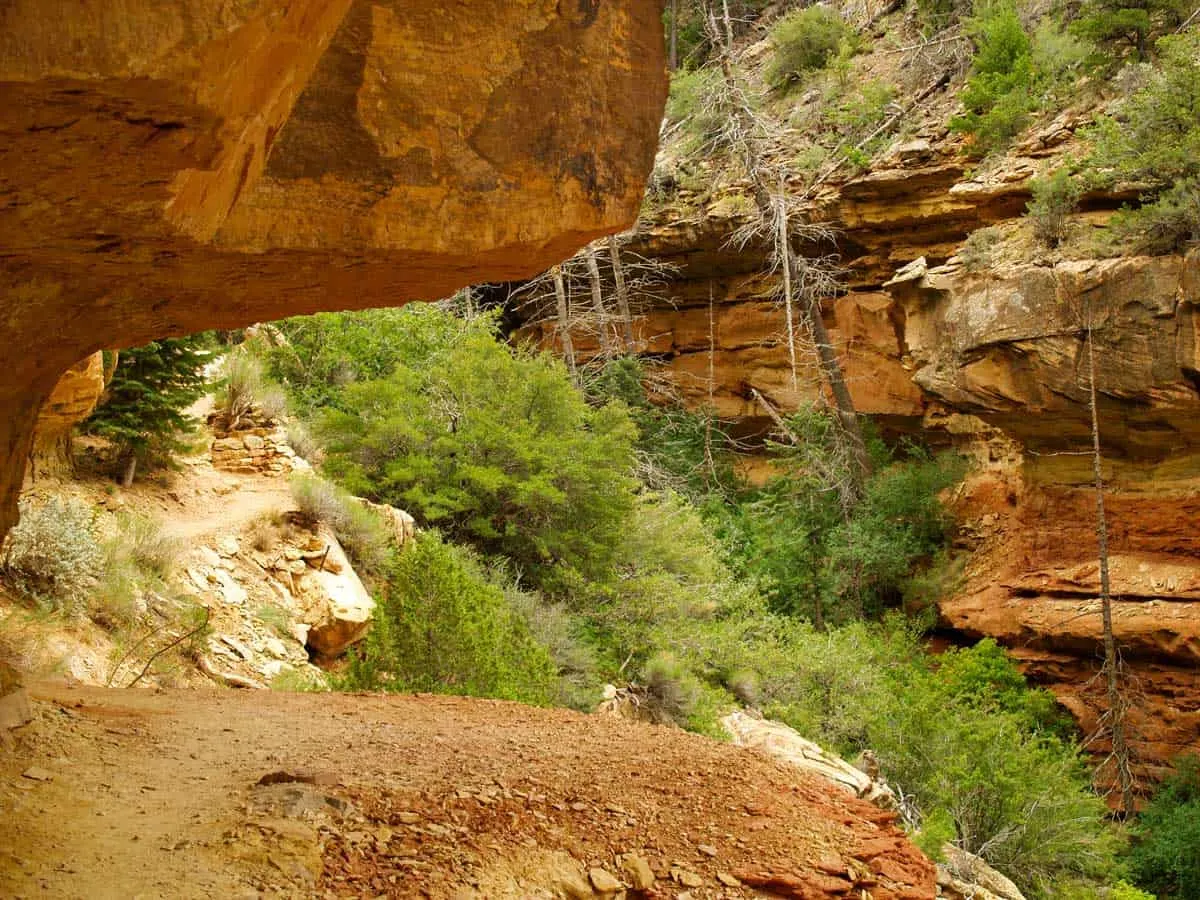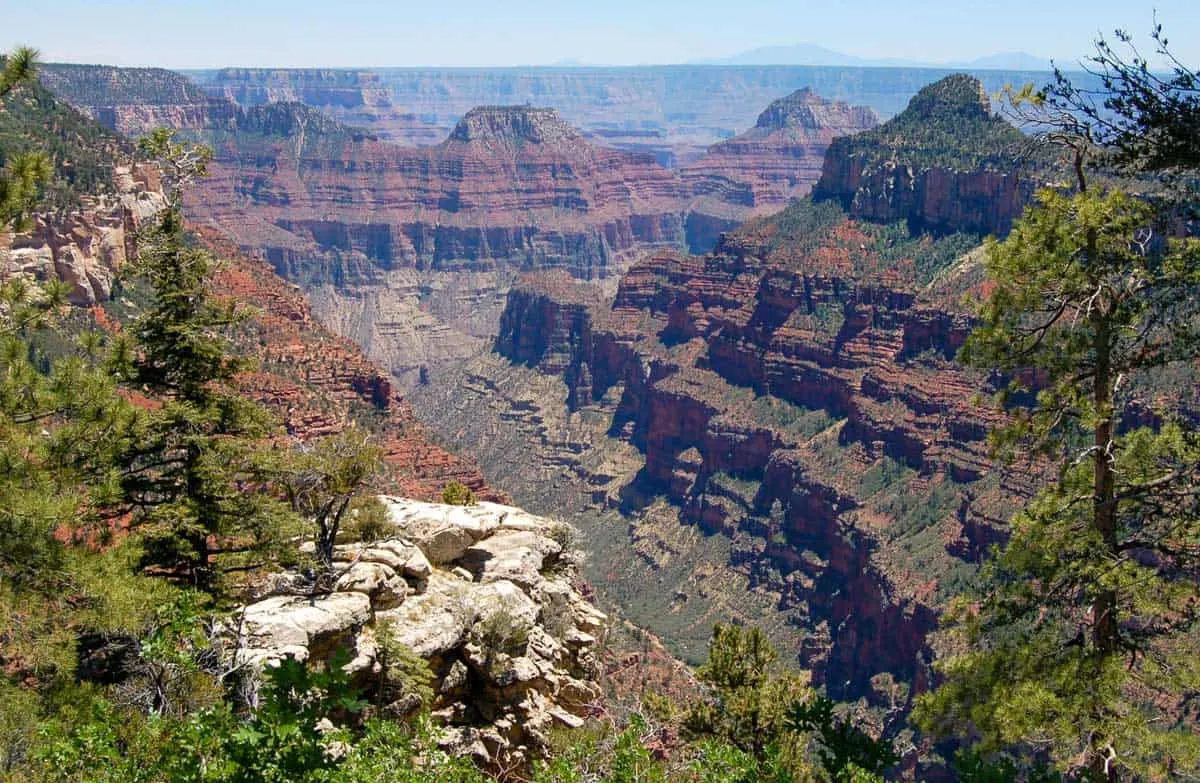Dramatic vistas and rock formations dressed in vibrant hues frame the expansive canyon etched out over 6 million years by the Colorado River. There are so many incredible day hikes in the Grand Canyon for visitors of every hiking ability.
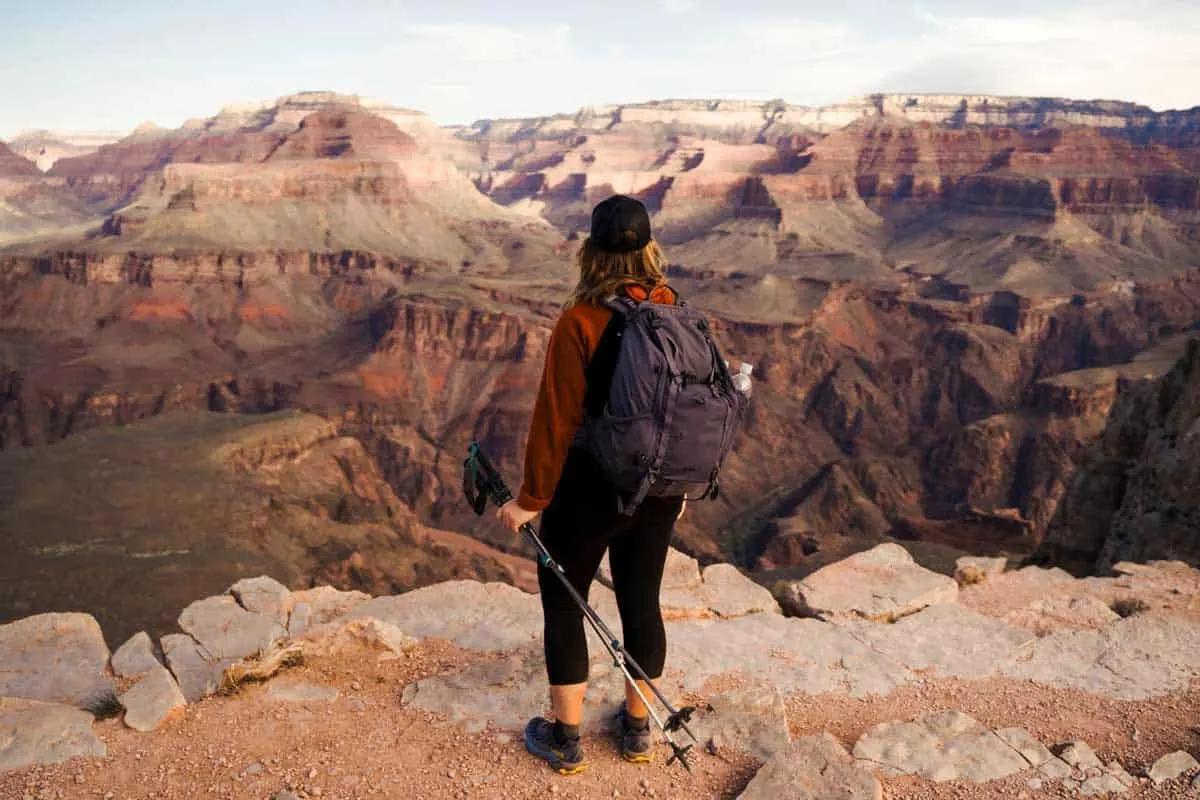
One of the most famous national parks in America. the Grand Canyon is one of the most astonishing natural wonders of the world, a once-in-a-lifetime destination attracting more than 6 million visitors each year.
A 4.5-hour drive from Las Vegas, the Grand Canyon National Park is one of the most beautiful natural destinations in Arizona.
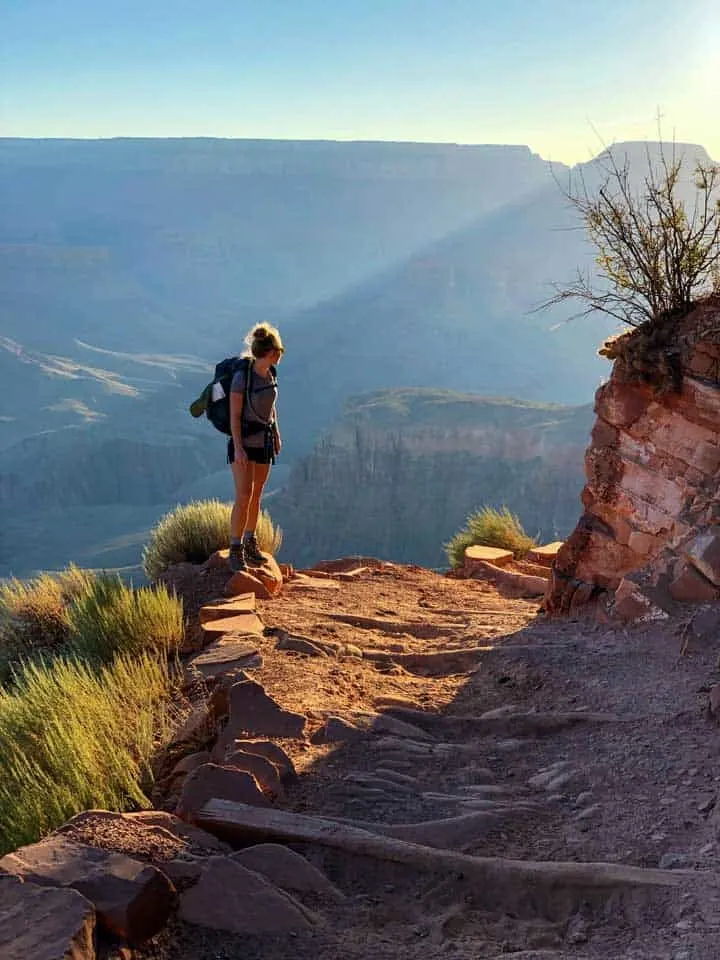
Hiking in the Grand Canyon
The Grand Canyon is one of the world’s premier hiking destinations, yet, most visitors never venture beyond the rim.
Sticking to the easily accessible pathways, sightseeing routes, and stops along the South Rim, many completely miss the beautiful landscape and scenery beyond the Canyon edge.
Understandably, the South Rim road makes sightseeing easy from the car or shuttle. Also, the thought of hiking the dusty descent beyond the rim can be intimidating for many visitors or amateur hikers.
But there are many accessible Grand Canyon day hikes for all abilities, so you can escape the crowds and experience the vast beauty of the canyon beyond the rim.
We have rounded up some of the best day hikes in the Grand Canyon so you can appreciate the vastness of this natural wonder without the crowds.
Each of these hikes is achievable within one day and caters to all fitness levels.
Want More Hiking Vacations Ideas? These incredible Hiking Destinations in America will have you longing for the great outdoors.
Where to Stay in the Grand Canyon
If it’s your first time visiting the Grand Canyon, be aware that hotels located as far as a 1.5-hour drive away can still carry the “Grand Canyon” label which is not ideal for early morning hiking, which we recommend. However, places like Flagstaff is a great Grand Canyon day trip base, which opens up the possibility of exploring other state and national parks in the area.
There is a fantastic array of hotels and lodges in the Grand Canyon inside the park. Alternatively, in nearby Tusayan, a short 6-mile drive away. If you want to stay in the park, we recommend booking in advance.
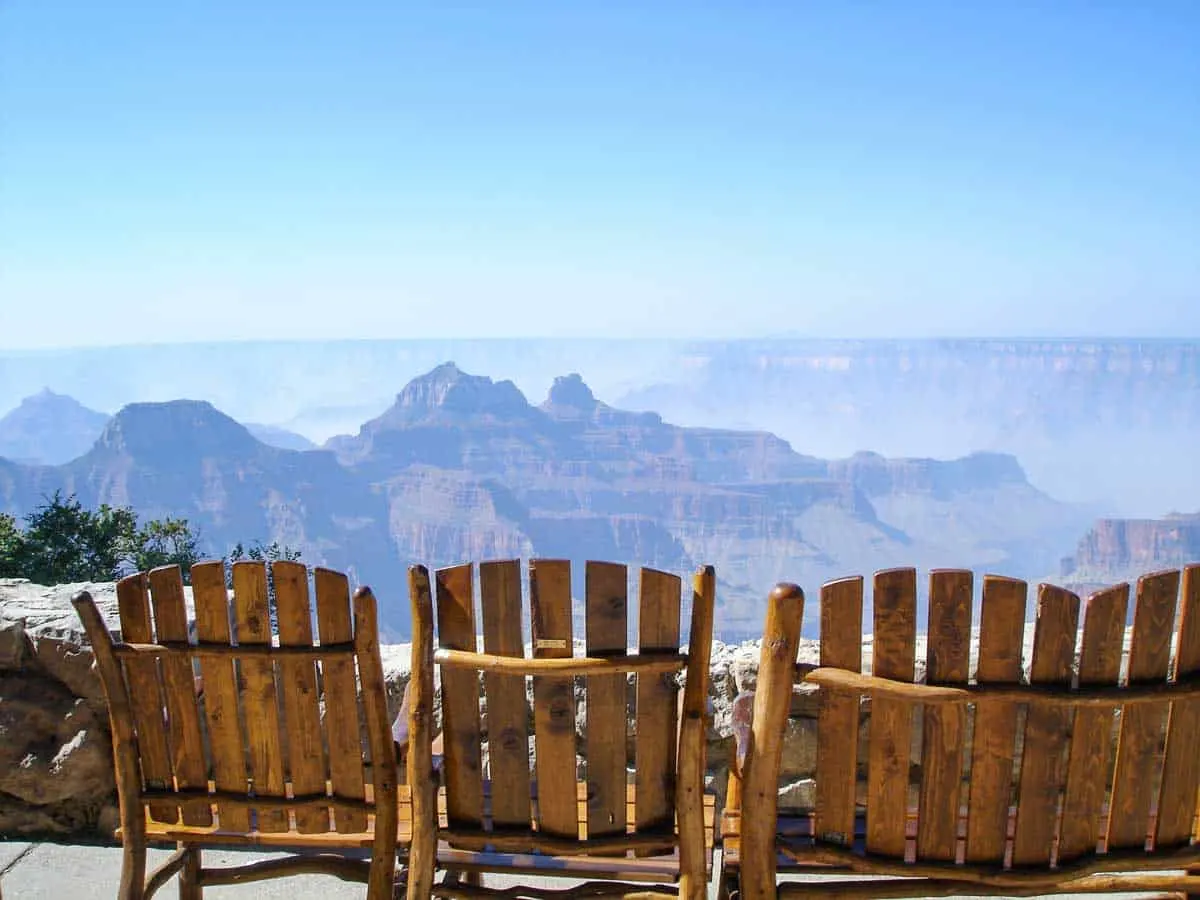
8 Grand Canyon Day Hikes For All Hiking Abilities
It’s understandable many tourists visiting the Grand Canyon can find hiking the park a bit intimidating. The vast canyon spanning a distance of 277 miles long and 18 miles wide, may seem incredibly daunting to explore on foot.
But for those who want to get off the tourist trail and explore beyond the rim, there is an excellent selection of Grand Canyon day hikes. Hikes that are suitable for various hiking levels, ranging from an hour to a full day.
These are eight top Grand Canyon North Rim vs South Rim day hikes to choose from.
Tips for Hiking in The Grand Canyon
There’s no denying, that hiking in the Grand Canyon can be dangerous. Take time to make sure you are prepared before setting off, even on some of the shorter day hikes.
We have some tips for packing for a hiking vacation here, but these are tips specific to hiking in the Grand Canyon.
- Consider the elevation, dryness, terrain, and heat.
- Choose the appropriate trail for your hiking ability.
- On hot days, avoid the hottest part of the day by setting off early.
- If planning a long day hike, leave your plans with someone or notify the visitors centre before setting off.
- Remember, it typically takes twice as long to hike out of the Canyon as it does to hike in.
- Ensure each hiker has plenty of water plus extra and you stay hydrated throughout the day
- Always have sun protection – a hat, sunblock, and sunglasses.
- Check the weather before setting off but be prepared for sudden changes in weather.
- Have layered clothing for weather changes.
- Hiking poles are recommended for the steep descent.
- Wear appropriate hiking boots that are already broken in.
- Pack snacks in your day pack, especially for longer day hikes.
- Carry a small first aid kit.
- There are loads of stuff for kids to do at the Grand Canyon but check if hikes are suitable before setting off with children, especially young children. Many are just too strenuous.
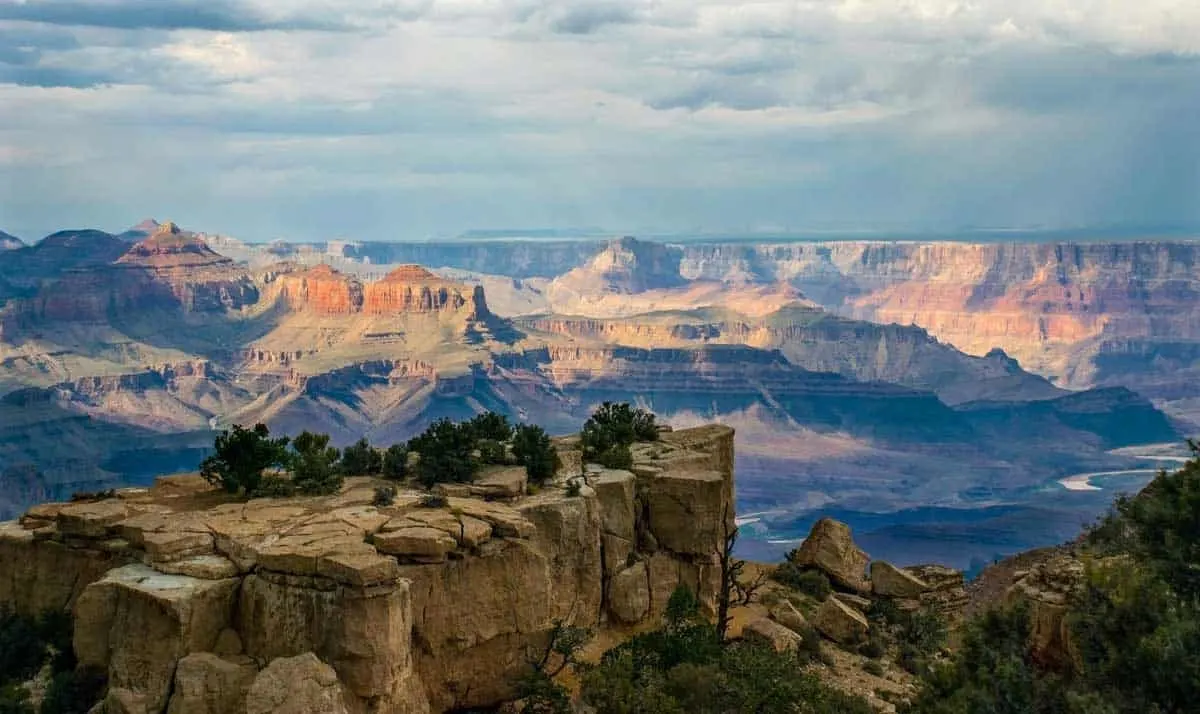
South Rim Day Hikes
South Kaibab Trail
- Distance: Hike ranges between 1.8 to 12 miles (round trip)
- Terrain: Steep
- Difficulty: Moderate to Strenuous (depending on length)
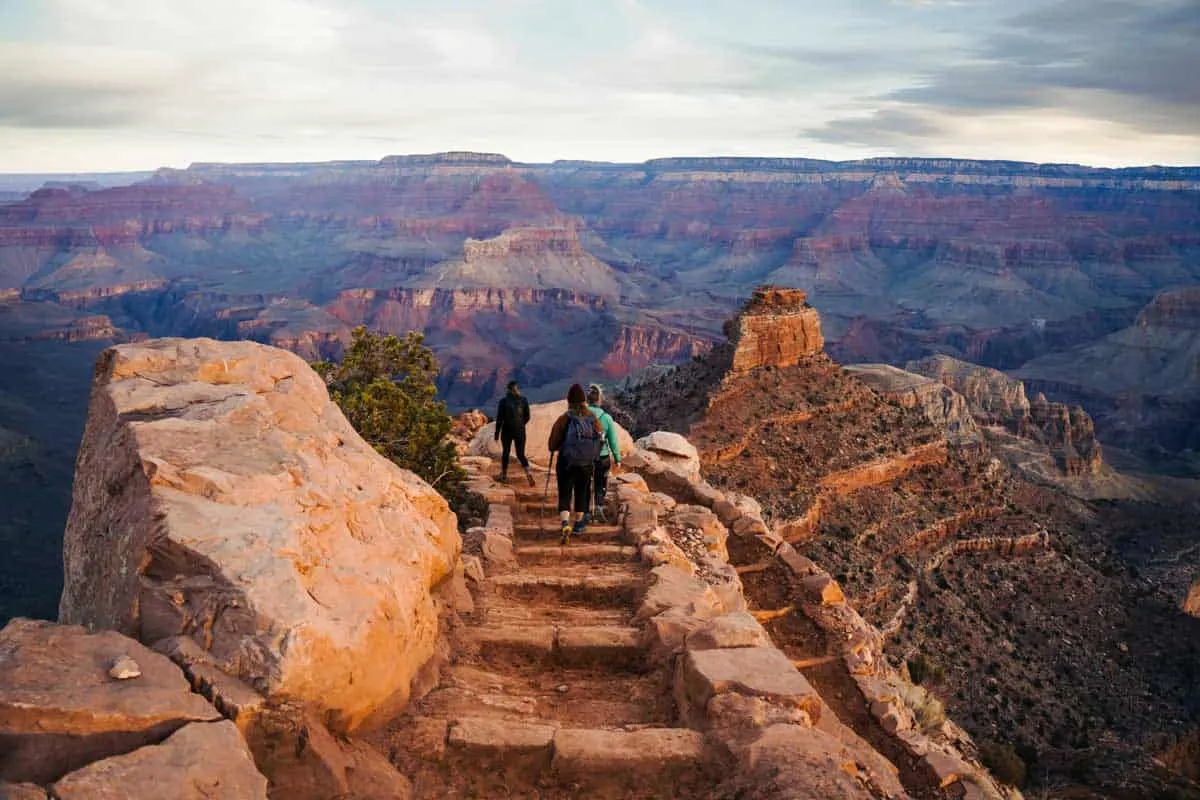
The South Kaibab Trail is undoubtedly one of the more scenic day hike options to consider, especially for first-time hikers in the Grand Canyon.
The total trail distance of this trail is around 12 miles round trip, leading down to the Colorado River. However, it is possible to break it into smaller hikes to one of the route stops along the way and return from there. It is not advisable to aim to complete the entire 12-mile hike as a day hike.
Route stops along the trail include:
- The Ooh-Aah-Point at 0.9 miles down (1.8 miles return), offering gorgeous views
- The Cedar Ridge route-mark at 1.5 miles down from the trailhead (3 miles return)
- Skeleton Point at 3 miles down (6 miles return), offering the first glimpse of the river.
It is essential to bear in mind, while these hikes may seem easy heading downhill, the return uphill hike is much steeper than many anticipate. Allow for twice the amount of time for the uphill trek.
For the best South Kaibab day hike consider hiking to the Cedar Ridge route marker. The trail starts nearby Yaki Point which is accessible only by taking the free Canyon shuttle bus from the Visitor Center, as no private vehicles are permitted at the trailhead. This particular hike has no water points along the way, so be sure to carry water at all times.
Shoshone Point
- Distance: 2 miles (return)
- Terrain: Fairly flat with a 100ft gain
- Difficulty: Easy
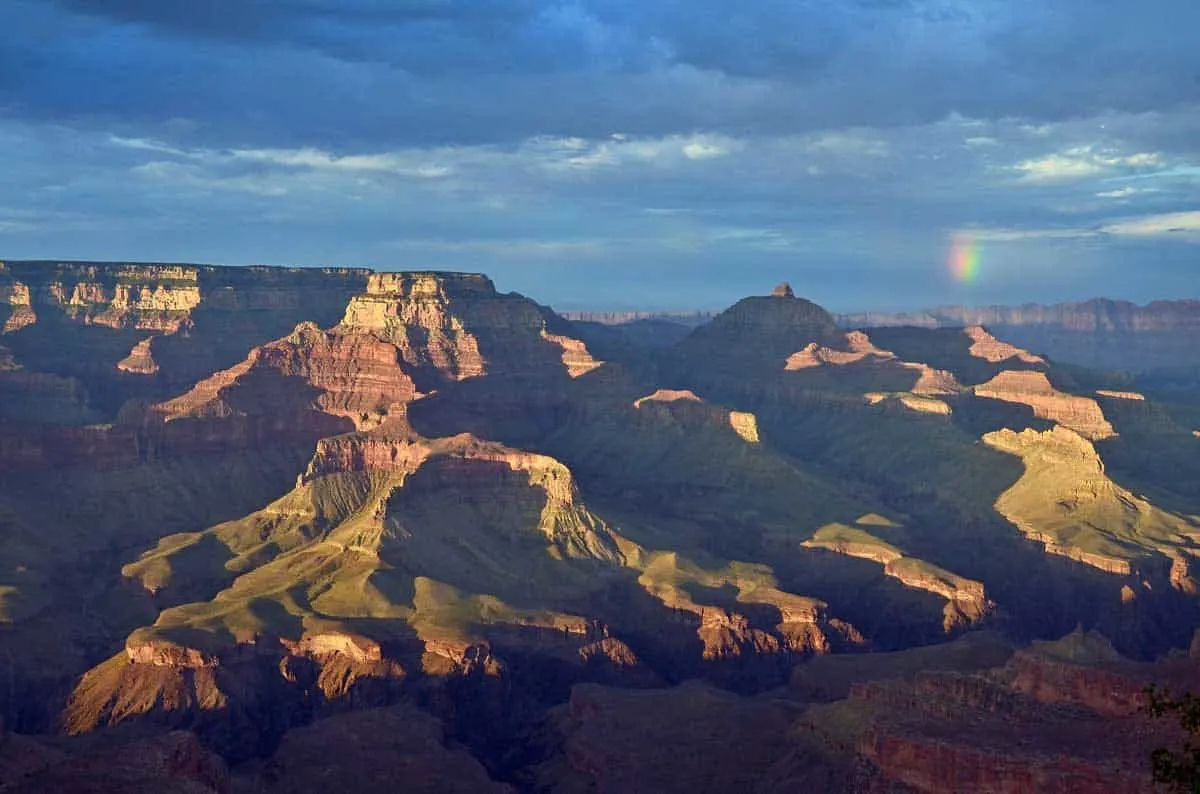
To escape the crowds of tourists and hikers visiting the South Rim, the Shoshone Point Trail is your best bet. One of the area’s best-kept secrets, this easy unpaved hike, meandering through pine forests is a simple 1-mile out-and-back walk to Shoshone Point. Here you’ll be able to admire the spectacular 180° views out over the Canyon.
The Shoshone Point trailhead is located at an unmarked spot on Desert View Drive, a short 8-minute drive from the Grand Canyon Visitor’s Centre. There is a parking lot with a nearby gate where the trail is accessed.
If you’re interested in hiking Shoshone Point, make sure to check in with the Visitor’s Centre ahead of time as the area hosts private functions throughout the year, so could be closed to hikers.
Grandview Trail
- Distance: 6.4-mile round trip to Horseshoe Mesa ( shorter hikes possible on this trail)
- Terrain: Narrow, rocky, sheer drop-offs, steep elevation
- Difficulty: Advanced
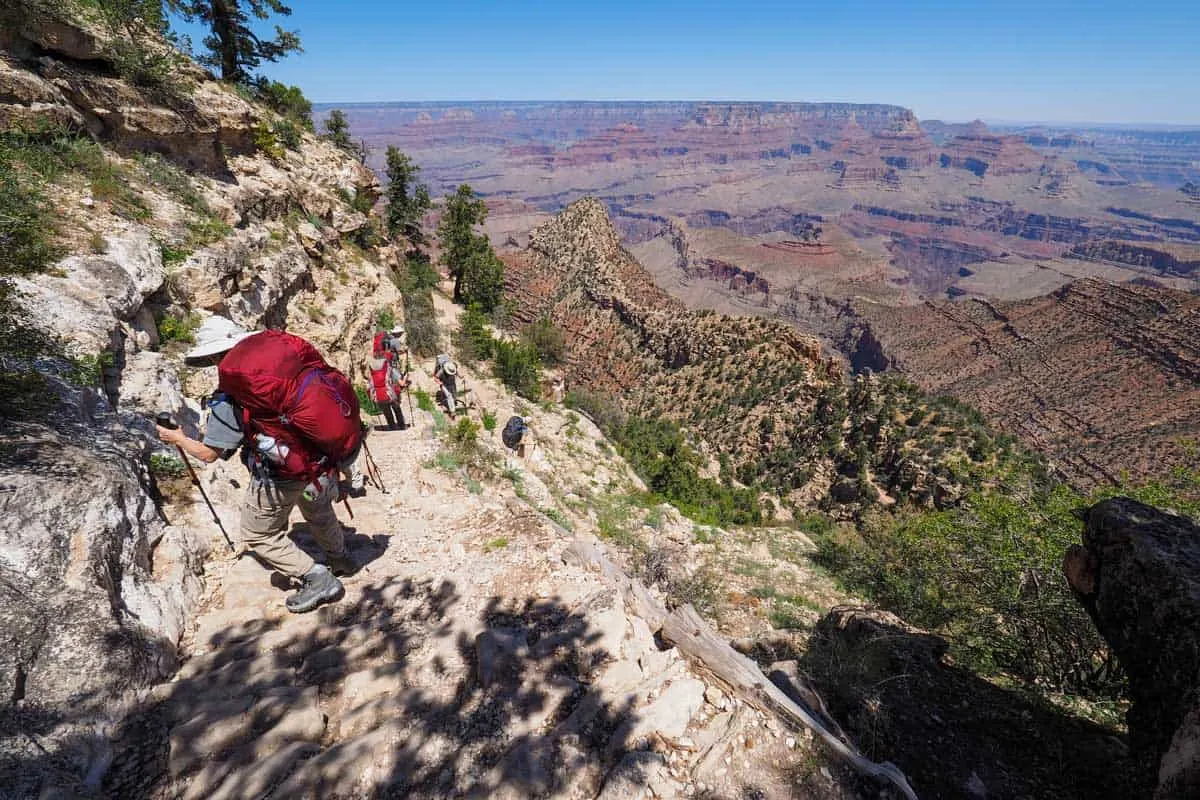
For a more strenuous challenge, hike the 6.4-mile return trip (with a 2500 elevation gain on the return) down to Horseshoe Mesa on the Grandview Trail. It is the perfect South Rim hike for those looking for a challenging day hike.
Originally a miner’s route, the Grandview Trail is not as well maintained compared to some of the other trails and is suited to more advanced hikers. Along the way, you will encounter rocky and narrow pathways with sheer drop-offs, not for the fainthearted.
For a shorter variation, consider hiking the 2.2-mile return trip to Coconino Saddle, or the 1.5-mile round trip to Sunset Nook which involves minimal elevation gain. As the name suggests, Sunset Nook is a fantastic spot for a memorable sunset over the Grand Canyon away from the crowds.
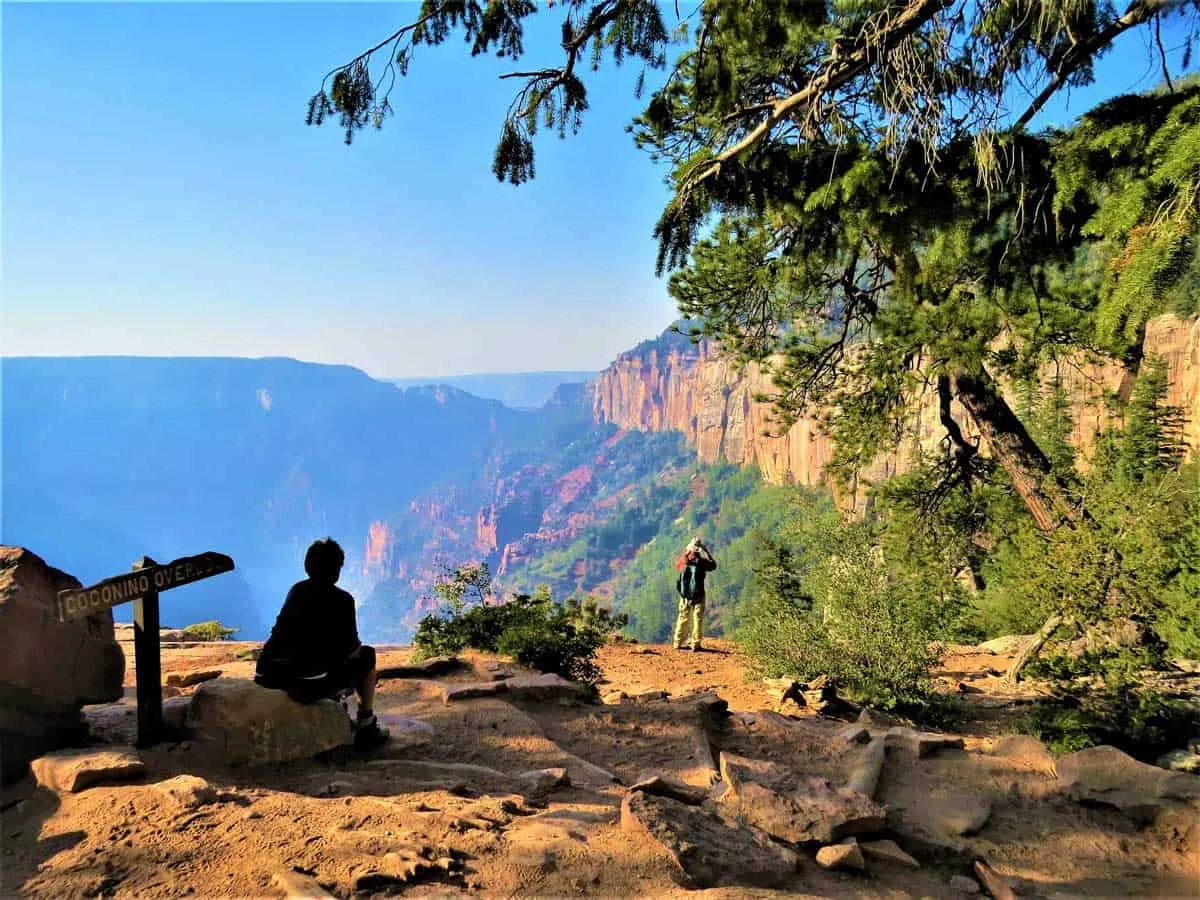
North Rim Grand Canyon Day Hikes
Bright Angel Point
- Distance: 0.5 miles (out and back)
- Terrain: Paved pathway
- Difficulty: Easy
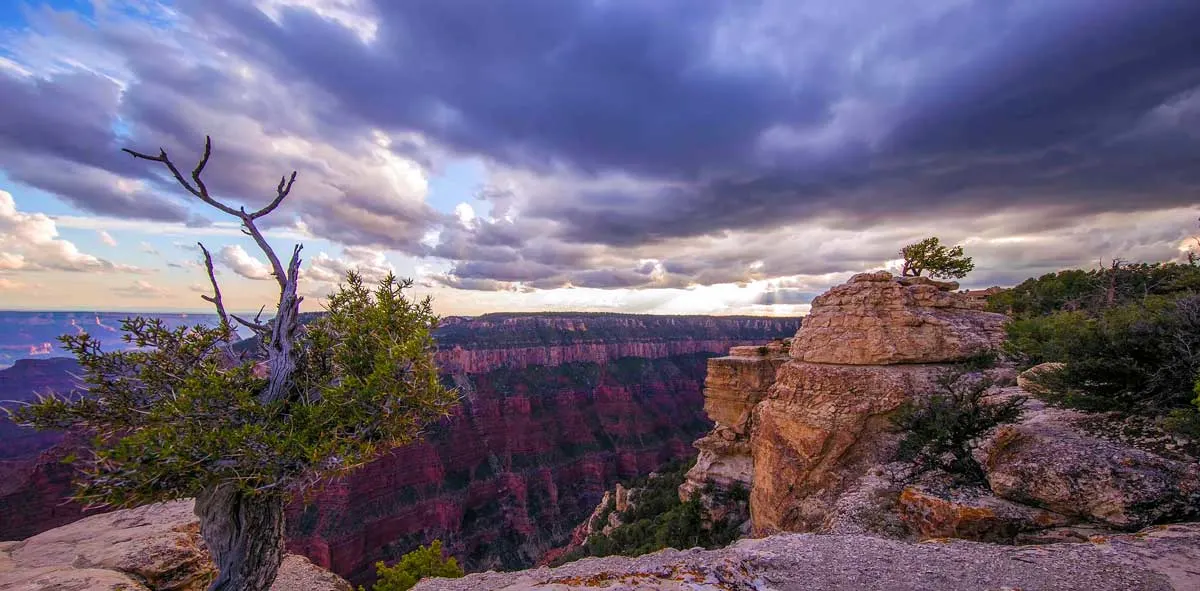
One of the shortest trails on our list is the very scenic and relatively easy Bright Angel Point hike.
A paved pathway starting at the south end of the Grand Canyon Lodge, the walk takes you along a short 0.5-mile return route to the Bright Angel Point vantage point. Bright Angel Point offers breathtaking 360-degree views out over the Canyon and the North Rim.
South Rim hikes tend to be far more popular than those on the North Rim. However, Bright Angel Point is the busiest of the North, mainly in part to its short distance and ease so can get busier than the other trails at times. We recommend an early morning or late afternoon/early evening hike here to avoid crowds.
North Kaibab Trail
- Distance: Trail variations ranging between 3.4-miles to 9.4-miles round trip
- Terrain: Steep
- Difficulty: Strenuous
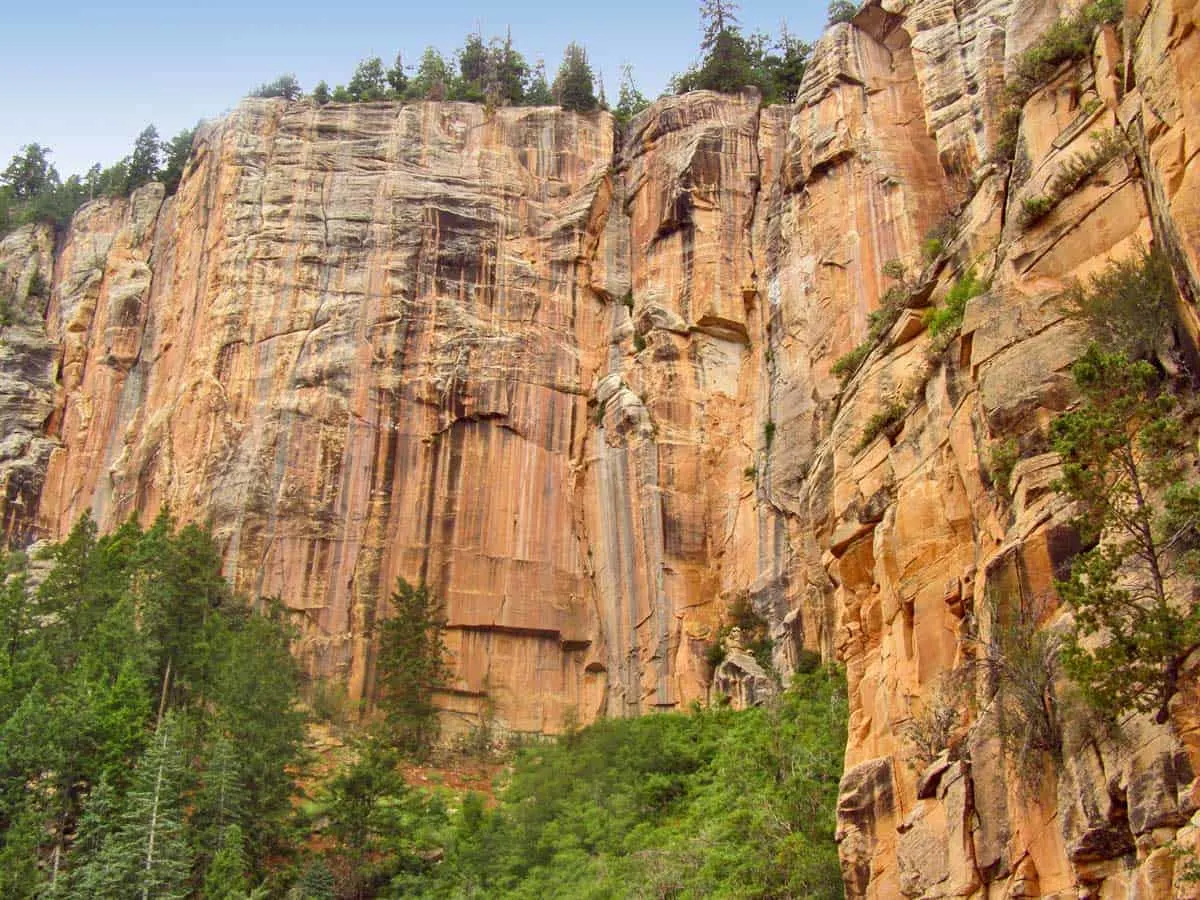
Undoubtedly one of the best, and also least visited of the North Rim day hikes is the well-maintained North Kaibab Trail.
If tackled as part of a multi-day hike, the trail descends for 14-miles to the river below. Even though this trail is known to be quite tricky, the diverse ecological landscape and beauty that include waterfalls, rock tunnels, and stacked switchbacks make it well worth the effort.
Thankfully though, there are various day hike alternatives to choose from:
- Hike to Coconino Overlook (a 1.5-mile return hike)
- Supai Tunnel (a 3.4-mile return) for sweeping views of the Canyon.
- More experienced hikers may enjoy the challenging 9.4-mile round trip hike to Roaring Springs. But, be warned, this hike descends 3050 feet beyond the canyon rim, so it’s advisable to start hiking no later than 7 a.m. to complete this full-day hike.
Cliff Springs Trail
- Distance: 1.4-mile out and back
- Terrain: Mostly flat with a 150 feet elevation change
- Difficulty: Easy
For a family day out, consider the easy 1.4-mile roundtrip Cliff Springs Trail that’s suitable for both adults and kids.
This side canyon hike easily meanders through a forested section before arriving at an opening with a large boulder and overhang, with a natural spring beside it (Note: it’s not safe to drink the water). From here, you can enjoy the gorgeous views out into the main Canyon.
Also, be on the lookout for the Native American pictographs and ruins left behind by the canyon’s original inhabitants.
Cape Final Trail
- Distance: 4-mile roundtrip
- Terrain: Fairly flat with a 150 feet elevation change
- Difficulty: Easy
The relatively easy Cape Final Trail is another off-the-beaten-track hike with far fewer hikers, due to its remote location. The walk along the canyon rim crosses through forested sections. It opens up onto one of the widest parts of the canyon with spectacular views out over the eastern Canyon, Vishnu Temple, as well as Jupiter Temple.
Tip: Camping is permitted at Cape Final, but the Grand Canyon National Park’s Backcountry Office only grants one permit per night to a lucky camper. Be sure to enquire as you may get to enjoy these astonishing views all to yourself.
Widforss Trail
- Distance: 10-mile round trip
- Terrain: Mostly flat with lots of shade
- Difficulty: Easy
The Widforss Trail, noted for its picturesque and ever-changing scenery, was named after artist Gunnar Widforss. The artist lived at the Grand Canyon in the 1930s, creating some of the most remarkable and detailed watercolour paintings of the Canyon.
This popular hike travels along the north rim for around 2.5-miles before turning into a pine and aspen forested section, which in itself is very scenic. Continuing for another 2.5-miles, the trail opens up into Widforss Point, affording stunning views out from the Canyon’s edge.
Although the route offers plenty of shade and is for the most part relatively flat, the high altitude (at roughly 8000 feet above sea level) may pose a slight challenge for some hikers.
Sunrise and Sunset In The Grand Canyon
Last but not least, there’s no better way to enjoy the Grand Canyon than at sunrise or sunset. Although, Sunrise or sunset over the Grand Canyon requires a little planning. From what time it will occur to the best places to watch it.
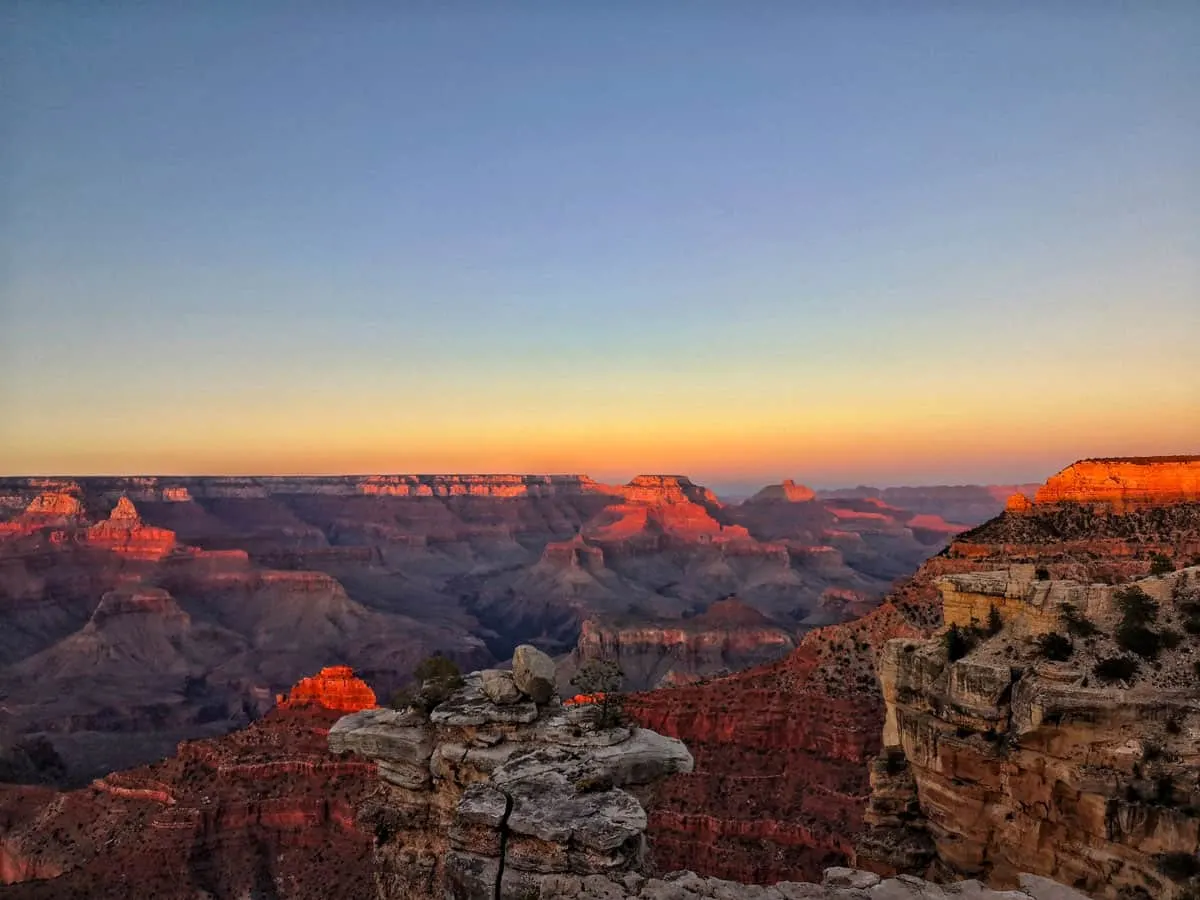
The Grand Canyon National Parks Service offers these tips so you can catch that legendary view.
Sunrise
The National Park Service suggests arriving at your chosen lookout at least half an hour before the sun clears the horizon and stay for an hour or so longer after.
Sunset
Be in position up to 90 minutes before the sun is due to set and stay at least 10 minutes after until the sun no longer illuminates the buttes and pinnacles – when the sky may turn red, pink, or orange.
Popular Grand Canyon Sunset Viewpoints
Hopi, Pima, Powell, Yavapai, Grandview, Mohave, and Mather.
If you can’t make it to any of these spots, just find your quiet place anywhere along the rim – you’ll undoubtedly be impressed no matter where you are.
For early birds, Yaki Point is an excellent spot for sunrise.
Want More Great Hiking Destinations in the USA? Try these fabulous hikes near Nashville or discover the best hikes in Joshua Tree NP for first visitors.

